skip to main |
skip to sidebar
I recently learned that my Minimoog appeared in Keyboard magazine, in a section that describes the custom synth cases built by Stephen Jones at Synthwood. The article has apparently been drawing wide interest in Mr. Jones' work, and I'd say it's well-deserved; his custom synth cases are things of beauty, and they make vintage equipment look better than new.
If you've found your way here from my Flickr page, I have blog posts that cover several aspects of my Minimoog restoration, including replacing the keyboard bushings, installing LED backlit mod and pitch wheels, and the cocobolo synthwood case. Here are links to all of the Minimoog posts:
Part 1: Intro
Part 2: Removing Spray Paint From the Rear Panel
Part 3: Replacing a Broken Power Cord
Part 4: Backlit Mod & Pitch Wheels
Part 5: Replacing Keyboard Bushings
Part 6: Cleaning the Keyboard Buss Bars (Fixing Bad Notes)
Part 7: Synthwood Custom Case
Here is the picture of my synth, as it appears in the January issue of Keyboard. Clicking on the image will take you to a PDF of the full article.

Dear Blog,
I'm afraid I just don't have time these days to do a lot of the hobby synthing I once did. I have a half-built theremin, a quarter-built TR-909 clone, and a totally un-built Vocoder kit sitting on the shelf. I chip away at them from time to time, but nothing will really come of them for a while.
I am keeping this blog up because I know there are people who do Google searches for Minimoog stuff and come across some of these posts. But I won't be adding any new material for a while.
I hope we can still be friends.
Murray
Wow... I guess I chose a bad time to not post for seven months. I've had a few people ask me what the hell the metal box is for in the last post. Sorry it's taken so long to follow that one up!
It's the future case for a theremin. I've always loved theremins, so I've decided to build one. Seven months ago.
It's not quite finished though. I've finished building the main circuit board, and it's really just a matter of mounting it all in the case, and making it look pretty. I have plans to have a nice front panel produced for me, but we'll see.
Here's a picture of the assembled circuit board:
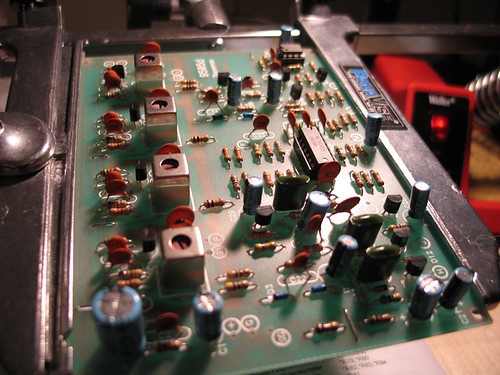
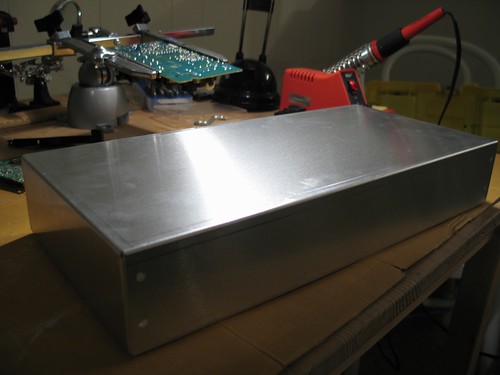
> What is he building now?
> I guess you'll just have to wait and see...
As far as I can tell, this is my final venture into minimoog pimpery. My mini looks so damn hot right now, you have no idea.
I was inspired when I saw this entry on Matrixsynth, one of the synth blogs I visit. The wood just looked so striking. I knew my synth wouldn't be totally pimped if I didn't have something similar done.
Synthwood is a small business owned by a father and son team, both named Stephen. They specialize in wood cases for vintage synthesizers. The case that caught my eye on Matrixsynth was their handiwork. I contacted them and told them what I was looking for. Basically I wanted the same wood as the Voyager, which was a wood called cocobolo.
Since the wood is exotic there was a bit of delay before they got some to work with, and since I'm in Canada it took forever to have the finished case shipped from Texas, where it was built by Stephen Sr.
I finally got it though, and to my dismay the rough handling of the box during shipment had caused the case to come apart! Basically all of the pieces that were glued together came unglued. As anyone who's done even a bit of woodworking can attest, it takes a lot of impact to break apart two well-glued pieces of wood. The case had even been padded in four or five cubic feet of packing pellets and wrapped in foam, so it would have taken quite a beating to do what was done to it. The good old US postal service must have just beat the shit out of that package.
The fortunate thing was that the wood itself was in good shape. I had heard that one or two other cases had been broken to splinters during shipment, so I was actually lucky. And now I had the choice of either sending the pieces back to Texas to be re-assembled, or I could try my hand at doing it myself. Of course I chose to do it myself. I know nothing of woodwork, but I like to learn new things so I gave it a shot. Stephen gave me his blessing and some pieces of advice, including the fact that cocobolo is poisonous. I guess I won't be eating it!
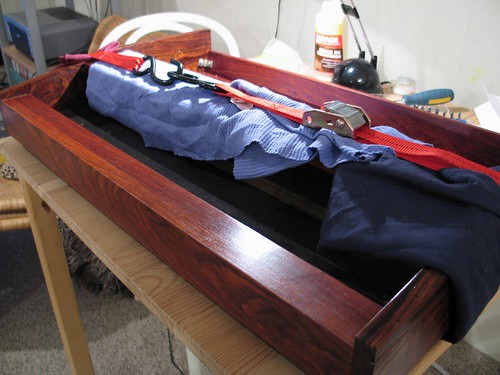 All of the pieces fit together, so all I really had to do was sand off the old glue and re-glue it together. Normally when you glue wood you're supposed to clamp it together while it sets. Because of the size of the case I wasn't sure how I was going to accomplish this, but I came up with a solution that worked well, as you can see in this photo. I found this strap device at Home Depot and it was perfect.
All of the pieces fit together, so all I really had to do was sand off the old glue and re-glue it together. Normally when you glue wood you're supposed to clamp it together while it sets. Because of the size of the case I wasn't sure how I was going to accomplish this, but I came up with a solution that worked well, as you can see in this photo. I found this strap device at Home Depot and it was perfect.
I wish I could say I glued it together perfectly in one try. It actually took me three tries because I kept finding mistakes I'd made with the alignment of the pieces. It had to be perfect, so I had to break it apart a couple of times and try again. I eventually got it though.
All I had left to do was to put the synth into the new case. This was a process too - I had to do a bit of cutting and drilling. I'll spare you any more details. After it was all done I gave it a new coating of linseed oil to bring the case to its full glory, and I was done:
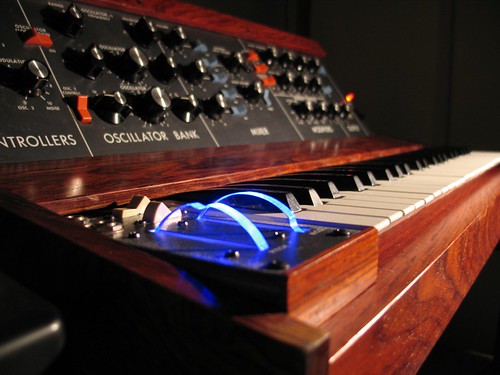 If this isn't a pimped-out minimoog I don't know what is. It was even featured on Matrixsynth, which is flattering. If you click on the photo it will bring you to more shots with detail of this gorgeous wood.
If this isn't a pimped-out minimoog I don't know what is. It was even featured on Matrixsynth, which is flattering. If you click on the photo it will bring you to more shots with detail of this gorgeous wood.
There you have it. This entire Pimp My Moog project was made possible by a few key people. I'd like to thank the Joneses of Synthwood (particularly Stephen Sr., who spent a lot of time on the phone with me), Archive Sound for the keyboard bushings, Mr. Kevin Lightner for his expertise and willingness to share, Fantasyjackpalance for the Minimoog resources, Dimension 3 Plastics in Vancouver for the clear wheels, and the folks at Moog Music for the tips (not to mention the stickers and youth-size t-shirt, which fits perfectly).
I'll have more projects to write about here soon, but that's it for a bit. Thanks for reading.
This is really a continuation of the last post because I did the work described here at the same time as I replaced the keyboard's bushings. A friend told me that some of my posts were too long to keep his attention so I'm trying not to write novels each time.
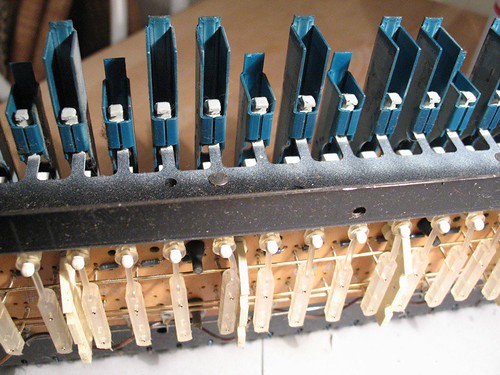 One thing that I noticed a few weeks ago was that certain notes on the Minimoog sounded strange when I played them. They sounded like the were cutting out, as if there was some kind of bad electrical connection. One particularly bad note would sometimes drift in an endless upward portamento, into tonal ranges beyond what you'd normally hear from a Minimoog. It made for a pretty cool effect, but not really what I wanted. Since I was going to have the keyboard out of the synth I thought I'd clean the part that's responsible for triggering notes.
One thing that I noticed a few weeks ago was that certain notes on the Minimoog sounded strange when I played them. They sounded like the were cutting out, as if there was some kind of bad electrical connection. One particularly bad note would sometimes drift in an endless upward portamento, into tonal ranges beyond what you'd normally hear from a Minimoog. It made for a pretty cool effect, but not really what I wanted. Since I was going to have the keyboard out of the synth I thought I'd clean the part that's responsible for triggering notes.
If you look under the keyboard, as shown in these photos, you'll get a glimpse at the mechanism that triggers notes. I can basically explain how it works but here's where it becomes obvious that some areas of my knowledge are lacking. Pressing a key causes a plastic doohicky to pull a rubber thingamabob forward. These are the technical terms. Each rubber thingamabob has two gold contact springs attached to it. When the rubber thingamabob is pulled forward, the gold springs each come into contact with one of two gold buss bars that span the width of the keyboard assembly. One of the buss bars is for the pitch of the note, and one is for triggering the note. I'd like to know more about how this works, in technical terms (if anyone knows, feel free to share), but my speculation is this: the buss bar acts as a variable-strength resistor, which outputs increasing voltages at various contact points from the left to the right. When a spring makes contact with the pitch bar on the left (where the low notes are), a low voltage is outputted, which results in a low pitch. The higher the voltage, the higher the pitch. I'm just speculating. I'd love to know more.
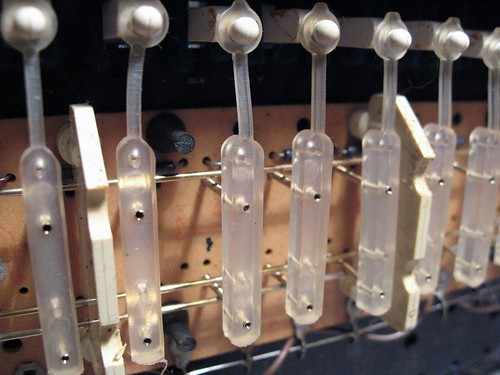 When I removed the keyboard from the synth it became obvious why certain notes were acting strange: the whole thing was filthy! There was dust buildup from over three decades of use. We're talking about BIG wads of dusty crap. Fortunately it was just dust - there was no evidence that anyone had ever spilled anything on the keyboard or anything like that. Most of the dust was taken care of with a can of duster spray.
When I removed the keyboard from the synth it became obvious why certain notes were acting strange: the whole thing was filthy! There was dust buildup from over three decades of use. We're talking about BIG wads of dusty crap. Fortunately it was just dust - there was no evidence that anyone had ever spilled anything on the keyboard or anything like that. Most of the dust was taken care of with a can of duster spray.
If you're doing work on a vintage synth and you're thinking about using a commercial product such as spray-on contact cleaner or control cleaner, please take this word of caution. I was going to do the same thing (after all, the Minimoog service manual recommends a similar product called Cramolin, which I believe is no longer available), but I did a little research first. I came across a couple of threads on the official Moog forums that made me decide against using a spray-on cleaner on the buss bar, and I'll probably never use one anywhere on the synth again. The threads are here (the posts to read are by Kevin Lightner, a synth tech with a LOT of experience):
http://www.moogmusic.com/forum/viewtopic.php?t=3194
http://www.moogmusic.com/forum/viewtopic.php?t=2381
In the end I used Isopropyl Alcohol and some Q-tips. It worked really well, and ALL of my weird note issues have been solved.
The synth is looking and feeling better and better. The last step, as far as I can see, is to get a new wood case. It's currently being produced by an outfit called Synthwood. It's going to be beautiful, as you will soon see.
A few days ago I received a package in the mail from Archive Sound. Inside the small parcel I found a plastic baggie filled with small slimy rubber bits. Just what I had been waiting for. These were, of course, the new bushings for the Minimoog's keyboard.
Minimoogs, like several other vintage synths, have keyboards made by a company called Pratt-Read. Apparently P-R stopped making synth keyboards many years ago, and now they make screwdrivers. I can't really find any info about P-R keyboards, their history in the keyboard-making business, or what made them give it all up for screwdrivers. Perhaps we'll never know. I'm waiting for the shocking tell-all novel, or at least a Wikipedia entry.
The bushings are the small rubber bits that fit snugly inside the individual keys, and as far as I can tell, their purpose is to give the keyboard a nice soft (almost squishy) action. Since these keyboards are so old now (mine's 34 years old), the rubber bushings become hard, and they sometimes even disintegrate. With old bushings, keys become uneven, and they have a harder action. Sometimes they click.
Installing the new bushings is a pretty simple job. If you get your replacement bushings from Archive Sound, they have instructions on their web site. I'll try not to be redundant here.
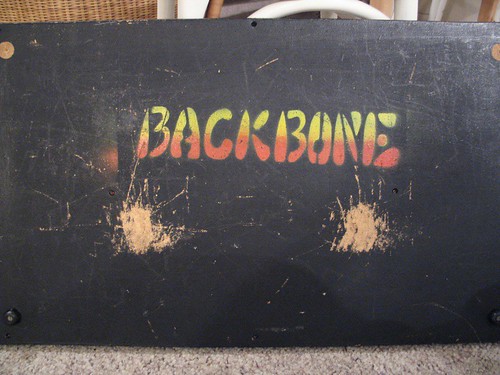 Removing the keyboard from the Minimoog is fairly simple. On the bottom of the synth are a bunch of wood screws keeping the bottom panel in place. The bottom of my synth has a little something extra, as you can see in the picture (Backbone lives!).
Removing the keyboard from the Minimoog is fairly simple. On the bottom of the synth are a bunch of wood screws keeping the bottom panel in place. The bottom of my synth has a little something extra, as you can see in the picture (Backbone lives!).
Once you remove the bottom panel you can see the keyboard assembly much clearer, and the screws holding it in place. The keyboard is connected via a cinch connector, which needs to be disconnected. MAKE SURE you mark the connector so that you can put it back together the right way. The keyboard is screwed into the case through some wooden shims that keep it at the right height. There are four of these shims (although I understand that some later versions don't have them). If the shims aren't glued in place, make sure you know which one goes where, as they are different heights. After the keyboard is unplugged and unscrewed it should just come out.
 Since the bushing replacement required the removal of the plastic key covers I took that opportunity to clean them. The whole keyboard assembly was really gross, actually, so I gave it a thorough dusting and I washed the keys in soapy water. Super-duster spray and Q-tips took care of the rest.
Since the bushing replacement required the removal of the plastic key covers I took that opportunity to clean them. The whole keyboard assembly was really gross, actually, so I gave it a thorough dusting and I washed the keys in soapy water. Super-duster spray and Q-tips took care of the rest.
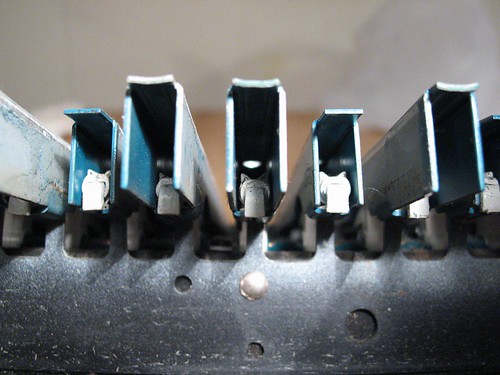 The bushings are the white bits with pointy ears visible inside the keys in the above picture. They are kind of awkwardly placed, so you need a tool well-suited to remove them. I found that a flat-head precision screwdriver (the kind used in computer repair) worked perfectly. You just need to jam the screwdriver under the bushing, work it a little bit, and pull it off. Some bushings don't come out in one piece, so the screwdriver also comes in handy for scraping remnants off of the key.
The bushings are the white bits with pointy ears visible inside the keys in the above picture. They are kind of awkwardly placed, so you need a tool well-suited to remove them. I found that a flat-head precision screwdriver (the kind used in computer repair) worked perfectly. You just need to jam the screwdriver under the bushing, work it a little bit, and pull it off. Some bushings don't come out in one piece, so the screwdriver also comes in handy for scraping remnants off of the key.
Once the old bushings are off, just pop the new ones on and you're set. Make sure you get the bushing right-side up. The bottom and the top look similar but they're not the same.
The keys on the synth feel a lot nicer now. The Pratt-Read bushing kit is a good buy if you want to bring some life back in to your old synth keyboard.










